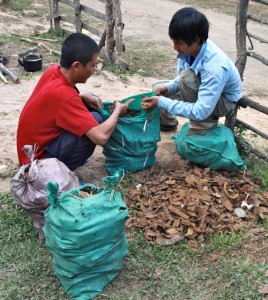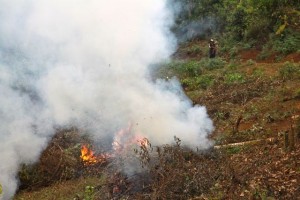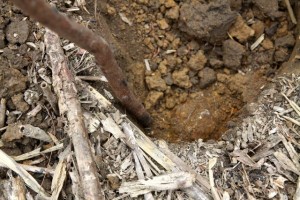Project Sekong 2012: Work is going slow. We’re finding cluster bomblets but also shrapnel by the bucketful.

When we work in areas that have been heavily bombed we must excavate thousands of bomb fragments. If the deminers ignore detector readings they might leave dangerous UXO behind.
Report 30
Our team is grinding along, clearing expansion garden plots, but it’s frustrating work. Early on we were fortunate to be working fields with little scrap, but now we are harvesting thousands of pieces of bomb frag every day. Metal shards by the bucketful.
We’re working both sides of a steep valley that is pockmarked with bomb craters. Old people in the village tell us that during the war the North Vietnamese had a depot here; when The United States discovered the encampment American planes flew hundreds of sorties over the site. One old villager told us that the bombing went on, around the clock, for days. He and his family took shelter in a bunker and remained hunkered down until the bombing finally stopped, afraid to leave for any reason.
During the war reconnaissance planes, trail watchers, or electronic surveillance equipment would pick up clues indicating a concentration of trucks or soldiers, and signal American forces in Thailand or Vietnam. Planes would then bomb the suspicious area. If the first bombs set off large secondary explosions pilots would know that they were on top of a supply depot or other lucrative target and would call for additional bombers to carpet the area.
Most of the large, general-purpose bombs that we find here are in the range of 250 to 750 pounds. Shrapnel from a bomb that size can fly nearly a mile, but most of the fragmentation in this narrow valley was contained in the hillsides, leaving us a highly contaminated site to clear.

Villagers clear fields ahead of our team, usually by burning grass and brush. Often, munitions explode while the fields burn so we insist that villagers burn far ahead of us. Too often villagers tending the fires venture too close and are killed.
If hundreds (or possibly thousands) of bombs were dropped here during the campaign that villagers describe, a failure rate of just two percent would leave a gaggle of unexploded bombs for us to locate and destroy.
The villagers whose gardens we are clearing just burnt these fields of dried brush last night so the land is covered with a thick layer of ash. Fortunately, our deminers are using some new metal detectors, models that are not confused by high carbon levels in the soil. Years ago, in Khammouan Province, our team used an earlier model that was tricked by carbon concentration and proved unreliable. The detectors our deminers have in hand today cost nearly three thousand dollars a pop and have bells and whistles not found on the coins-on-the-beach models you can buy at Walmart.

When we are near suspected ordnance we have the benefit of our metal detectors. Villagers don't and often mistake corroded bomblets for rocks. Can you find the bomblet in this photo? Are you willing to bet your life that you are right?
Update:
Before breaking for lunch we demolished several cluster bomblets that we found on the hillsides; they were so badly corroded that they were barely recognizable as ordnance. Villagers, working without the benefit of metal detectors, would likely have mistaken the bomblets for rocks, making an encounter all the more dangerous.
